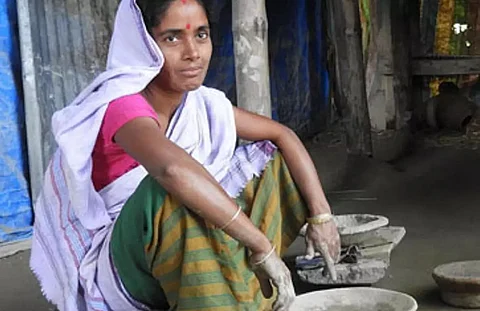
- Home
- Live Blog
- Breaking News
- Top Headlines
- Cities
- NE News
- Sentinel Media
- Sports
- Education
- Jobs

Ramkrishna Sarkar
(rksarkar265@gmail.com)
Our relationship with the soil and nature is very close, and many beautiful things can be made with this soil, which we like very much. Asharikandi: In this village, the people make many types of pottery items. This village is famous for its traditional crafts, such as terracotta and pottery. It is one of the largest clusters of terracotta and pottery in India.
Asharikandi is a village in the Dhubri district of Assam. The village is located 14 km east of Dhubri town, 7 km from Gauripur town, and 215 km west of Guwahati.
The primary raw material required for this craft is HIRAMATI (clay soil), which is available in the areas near villages. The artisans collect the clay from the river banks with a spade or kodal. The clay is soaked overnight, and its impurities are removed with khota. A khota is a thin tool made of bamboo. The next stage is the kneading of the composition with hands and feet under the sun to attain elasticity. The clay is then mixed with water, sand, and caustic soda. This mixture ensures that there are no cracks in the finished products. The artisans use two instruments—the boila and pitna—to give the clay a good shape. They also use knives to carve designs on the products. Once the products get ready, they are dried in sunlight for a few days, and a powder prepared from the red clay (Kabish) is applied to them. Finally, the products are baked in a traditional kiln.
The name Asharikandi is derived from the combination of two words, Ashar and Kandi.
ASHAR, or AXAR, is the third month in the Assamese calendar, and KANDI means “shedding tears”. During ASHAR, heavy rainfall creates flooding in this low-lying area, which causes the people of this place to shed tears out of misery. Especially potters suffer a lot. Because they cannot store their earlier products and other items safely during the rainy season.
The terracotta artefacts of Asharikandi contain a wide range of products that can be used for different purposes. They include kitchen items, ritual items, toys, decorative items, idols of God and goddesses, statues of eminent personalities, etc. The “Hatima doll,” or “mother and child doll,” is said to be the most popular artefact of Asharikandi. The word Hatima describes the mother with elephant-like ears carrying her child on her lap. In 1982, the late Sarada Bala Devi was conferred with the President’s Award for her traditional terracotta craft, the Hatima Doll.
Asharikandi village is surrounded by the River Gadadhar, a tributary of the mighty Brahmaputra. The riverine path is used for distributing and marketing the products.
PM Narendra Modi also mentioned the terracotta of Asharikandi on his radio programme “Mann Ki Baat”.
The Assamese terracotta art and culture took their birth in Asharikandi through a few clusters of pottery families. Today, more than 80 percent of the families of this village are engaged in this ethnic art (handicraft) and pass their lives after selling the terracotta items in the national and international markets.
Traditionally, most of these families belong to the ‘Paul’ community of Bengali ethnicity. In Assam, ‘Paul’ means Kumar (that is, potter). These days, the Dhubri district has acquired a pivotal position in the terracotta and pottery markets in India and abroad. The village of Asharikandi continues to create wonders out of clay, and this rich tradition is kept alive generations after generations.